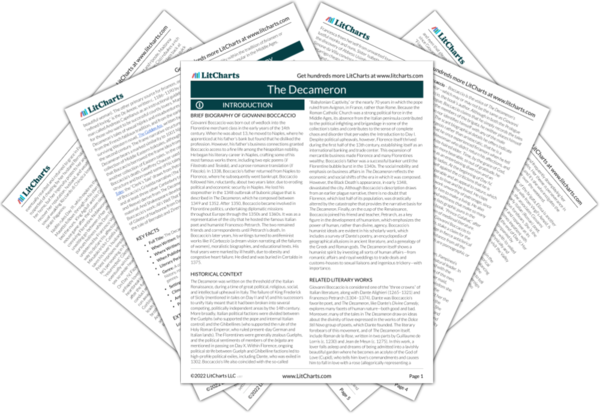Love and Sex
Stories of love abound among the tales and songs composed by the members of the brigata (the ten young women and men who narrate The Decameron’s tales) who have escaped plague-ridden Florence for the countryside. Love appears in many guises, although it primarily falls into the exalted literary guise of fin’amors (refined love) or, in stark contrast, the funny and sometimes graphic exploration of human sexuality that can be found in the fabliaux tradition—raunchy…
read analysis of Love and SexMen and Women
Although Boccaccio dedicates The Decameron to women, who make up the majority of the brigata (the ten storytellers) and are the protagonists of many of its tales, the book’s outlook is decidedly patriarchal and even directly anti-woman. In general, the tales’ women are assigned negative character traits, objectified by the men around them, and find themselves vulnerable to physical and emotional violence.
The Decameron aligns with medieval gender hierarchies that place men over women. Filomena…
read analysis of Men and WomenModeration and Excess
The ladies and gentlemen who tell The Decameron’s tales leave Florence to escape an outbreak of the bubonic plague which has profoundly destabilized their society. Their country lifestyle demonstrates the moderation that a functioning society requires. In its exploration of moderation and excess, The Decameron presents excess as always detrimental and moderation as one of the highest virtues.
The excess desire of King Philip II for the Marchioness of Montferrat and the French Princess …
read analysis of Moderation and Excess
Intelligence
In the Prologue to The Decameron, Boccaccio explains that he wrote it to entertain and teach the ladies to whom it is dedicated. Both the frame story—in which a group of ten young, noble Florentines flee to the country to escape the plague—and the tales they tell stress the importance of intelligence and wit. Despite its emphasis on love, intelligence may in fact be the highest and most powerful virtue in The Decameron…
read analysis of IntelligenceClass and Character
The members of the brigata, the ten young people who tell The Decameron’s tales while waiting out the plague in the countryside surrounding Florence, are all aristocratic. In contrast, many of the tales’ characters are middle-class merchants, doctors, lawyers, and artists; some are peasants and servants. This mix of social classes allows The Decameron to claim that character is a better indication of nobility than wealth or status. While some characters are consigned…
read analysis of Class and CharacterFaith vs. Religion
The Decameron’s frame narrative begins in a church, where ten young noblemen and women decide to leave plague-ravaged Florence for the countryside. There, they tell one hundred tales that are firmly embedded in medieval literary and cultural contexts that, in turn, assume a nearly universal practice of Christianity. But although Christianity undergirds the work’s worldview, the members of the brigata (the ten storytellers) treat sincere faith as a separate entity from the religious and…
read analysis of Faith vs. Religion






